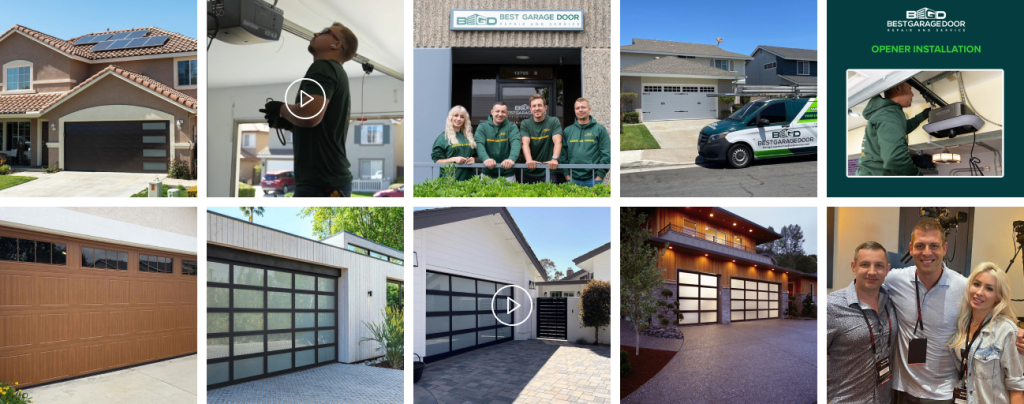
Garage door seals are crucial for safeguarding your garage against water damage, energy loss, and unwanted pests. These seemingly small components make a big difference in maintaining your garage’s integrity, comfort, and security. Ensuring your garage door is tightly sealed is crucial for blocking moisture that can lead to mold and structural harm, reducing energy expenses for heating and cooling, and keeping away pests like rodents and insects.
In this guide, we’ll navigate the world of garage door seals, offering insights on selecting, installing, and maintaining the ideal seal for your needs. Whether facing harsh weather, aiming for energy efficiency, or ensuring a pest-free space, understanding how to choose the proper garage door seal is critical. Let’s enhance your garage’s protection together.
Why quality garage door seals matter
Protecting your garage from extreme weather conditions
Garage door seals are essential for shielding your garage against harsh weather. They keep rain, snow, and wind at bay, ensuring your garage stays dry and undamaged.
Enhancing your home's energy efficiency
Quality seals also help improve your home’s energy efficiency by sealing gaps and maintaining a consistent temperature inside the garage. This reduces energy bills and promotes eco-friendly living.
Keeping pests and debris out
In addition to weatherproofing, seals are a barrier against pests and debris, maintaining a clean and secure garage environment.
Types of garage door seals and their benefits
Bottom seals
Bottom seals come in various materials and designs, offering unique benefits. Rubber seals provide flexibility and durability, while vinyl seals offer weather resistance. T-style seals create a tight seal, while bulb-shaped seals provide insulation against drafts.
Threshold seals
Installed snugly at the base of the garage door opening, threshold seals act as a barrier, effectively warding off water, debris, and unwanted pests. They maintain temperature consistency, improve energy efficiency, and reduce heating and cooling costs.
Weatherstripping and brush seals
Weatherstripping and brush seals seal gaps around the sides and top of the garage door. Weather stripping prevents drafts and moisture, while brush seals block debris and pests. Choose based on your garage’s specific needs.
Understanding the basics of garage door seals

Garage door seals protect your garage from external elements such as water, debris, and pests. They also help maintain temperature control within the garage, which is crucial for energy efficiency.
Bottom seals and retainers: The bottom seal is one of the most critical parts of your garage door’s sealing system. It is affixed to the bottom edge of the door and can vary significantly in shape and material. Sometimes, replacing the bottom seal necessitates replacing the retainer as well. Retainers are metallic or plastic components attached to the door panel holding the bottom seal. The complexity of retainers can vary widely, with many shapes and thicknesses that must match the door panel design.
Choosing the right retainer
Retainers come in various forms and ensure the bottom seal is fitted correctly. If your garage door panel has been damaged or the retainer is not in perfect condition, it’s advisable to consult a specialist. At Best Garage Door Repair and Service (BGD), our commitment extends beyond mere service – we deliver tailored expertise and meticulous attention to detail, guaranteeing your garage door seals are flawlessly installed and fully operational.
Universal Retainers: Universal retainers are an excellent choice for standard door depths. They are designed to fit the most common door thicknesses, typically 1 3/8 inches and 2 inches. These retainers can be attached to almost any garage door panel if the correct depth is selected. T-shaped bottom seals are commonly used with these retainers for an effective seal.
Custom solutions for unique situations
In situations where standard solutions do not suffice, such as with custom garage doors, fully universal retainers are available. These are adaptable to virtually any door depth and are ideal for non-standard doors. They are installed on the external side of the door first and feature a large gap and flexible composition, often made of a composite rubber material that can be adjusted to fit any door width.
Conclusion
When selecting garage door seals and retainers, consider your door’s specific requirements and the conditions it needs to withstand. Whether you need a standard solution or a custom fit, BGD is here to help. Our expert guidance ensures your garage door remains secure, efficient, and fully functional for years.
Garage door seals demystified: A look into leading brands' offerings
Here are some examples of different forms and types of retainers and bottom weather seals used by the most popular garage door brands in the USA:
- Clopay: Clopay offers a variety of garage door bottom seals, including the EPDM Rubber Weather Seal, designed to fit the bottom retainer of Clopay residential steel doors. The seal forms a bulb shape when installed, ensuring a tight seal over uneven garage floors
- Amarr: Amarr provides Triangle End Vinyl Garage Door Bottom Weatherseals designed for a tight fit and easy installation. They are compatible with various Amarr door models and protect against dirt, dust, and pests.
- Wayne Dalton: Wayne Dalton presents a diverse range of bottom seals, encompassing adaptable vinyl and rubber seals renowned for their effortless installation and superior defense against outdoor elements.
- Raynor: Raynor garage doors typically use durable rubber seals that conform to uneven floors and provide a reliable barrier against weather and debris.
- Chamberlain and LiftMaster: These brands often use weather seals as part of a comprehensive door system, focusing on integration with their door openers for optimal functionality.
- C.H.I.: offers a variety of garage door seals designed to enhance the aesthetic and functional aspects of their doors, including bottom seals that provide excellent weatherproofing.
- Genie: Genie’s garage door seals are designed to be versatile and durable, suitable for various garage door types and sizes.
Every brand showcased here provides distinctive solutions meticulously crafted for their specific door systems, ensuring diverse choices to cater to many requirements and preferences. For the best results, it is recommended that you consult with a professional installer from our team to choose and install the correct type of seal for your specific garage door system.
How to choose the proper garage door seal

Selecting the ideal garage door seal enhances your home’s efficiency and protection. This brief guide covers the essentials: assessing your needs, installation tips, and maintenance advice.
Assessing your needs
Weather conditions: Choose seals designed for your local climate, especially if you experience cold winters in Orange County. Keywords like “best garage door seal for cold weather” will guide your search.
Garage door type: Ensure compatibility with your door type — whether roll-up, sectional, or side-hinged.
Pest control: Opt for tightly fit seals to prevent and reduce dust.
Measurement and installation tips
- Measure your garage door: Note the width, thickness, and gap between the door and the ground.
- Select the proper seal: Match your measurements with the right product, focusing on terms like “best garage door bottom seal.”
- Install properly: Follow the product’s instructions for DIY installation, which might involve adhesives or clips.
Maintenance and longevity
Regular maintenance extends your seal’s life. Inspect it annually for damage, and clean it with soap and water to prevent buildup. Replace the seal every few years or whenever significant wear is noticed.
By carefully choosing, installing, and maintaining your garage door seal, you’ll ensure your home stays energy-efficient, secure, and well-protected against various elements.
Best practices for installation
Proper installation of a garage door seal enhances its effectiveness and longevity. Here’s a concise guide, including common pitfalls to avoid.
Step-by-step installation guide
- Clean the area: Ensure the bottom edge of the garage door and the floor are free from debris and old sealant.
- Measure accurately: Double-check the door width and gap height. Select a seal that fits these dimensions.
- Trim the seal: Cut the seal to match the door’s width for a perfect fit.
- Apply adhesive (if needed): Follow the manufacturer’s instructions to apply glue to the door or floor.
- Install the seal: Align and press the seal into place, starting at one end and moving to the other.
- Secure the seal: Use fasteners or screws if required, ensuring they are evenly spaced.
- Check the fit: Close the door to test for gaps or misalignments, adjusting as necessary.
Common mistakes to avoid
- Mismatched seal and door type: Ensure the seal matches your garage door type.
- Poor surface preparation: A clean surface is crucial for a good seal.
- Inaccurate measurements: Precision is critical to preventing gaps.
- Rushed Installation: Take your time to align and secure the seal properly.
FAQs on garage door seals
Q: What seal is best for cold weather?
A: Use durable rubber or silicone seals with thermal insulation to block cold air and reduce heat loss.
Q: How often should seals be replaced?
A: Inspect annually and replace every few years or sooner if you notice cracks, gaps, or stiffness.
Q: Can I install a seal myself?
A: Yes, with essential tools and the manufacturer’s instructions, most garage door seals are designed for DIY installation.
Q: What’s the difference between bottom and threshold seals?
A: Bottom seals attach to the door’s bottom edge, while threshold seals affix to the garage floor, enhancing protection against water and pests.
Q: How do I choose the correct seal?
A: Consider your needs, the type of door, and the gap size. Measure the door’s width and gap height for a precise fit.
Conclusion
The proper garage door seal enhances your home’s protection and energy efficiency. A properly chosen and installed seal not only safeguards your garage against harsh weather conditions and unwanted pests but also contributes to maintaining a comfortable indoor climate, leading to potential savings on energy bills. Take the time to assess your current garage door seal’s condition and effectiveness. If it’s showing signs of wear or you’ve noticed drafts and pests making their way into your garage, it might be time for an upgrade. Investing in a high-quality garage door seal moves you closer to achieving a safer, more energy-efficient, and cozier home. Don’t wait for the elements to take their toll—evaluate your needs and make the necessary improvements today.




